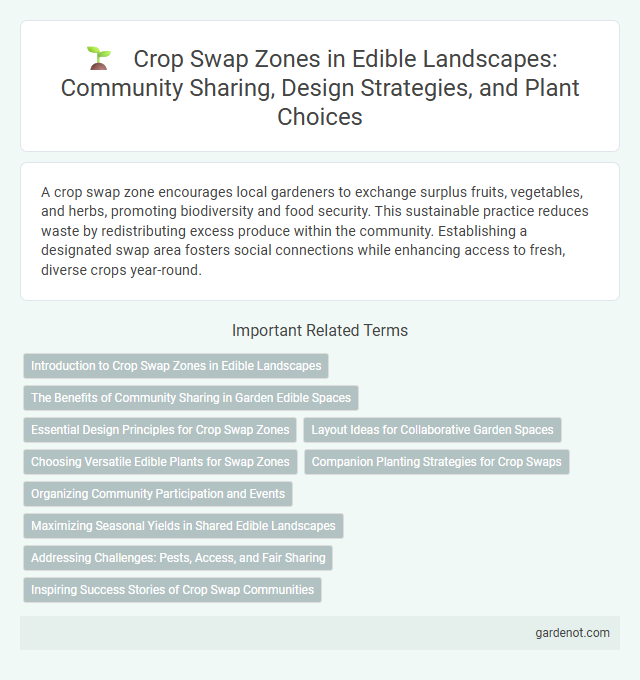A crop swap zone encourages local gardeners to exchange surplus fruits, vegetables, and herbs, promoting biodiversity and food security. This sustainable practice reduces waste by redistributing excess produce within the community. Establishing a designated swap area fosters social connections while enhancing access to fresh, diverse crops year-round.
Introduction to Crop Swap Zones in Edible Landscapes
Crop Swap Zones in edible landscapes serve as designated areas where gardeners exchange surplus produce, fostering community engagement and reducing food waste. These zones encourage biodiversity by introducing a variety of crops that benefit local ecosystems and improve soil health. Integrating Crop Swap Zones enhances sustainability and supports local food networks within urban and suburban gardening projects.
The Benefits of Community Sharing in Garden Edible Spaces
Crop swap zones foster community sharing by enabling gardeners to exchange surplus produce, diversifying access to fresh fruits and vegetables while reducing food waste. These shared spaces enhance local food security and promote biodiversity by encouraging the cultivation of varied crops within edible landscapes. By connecting neighbors through mutual exchange, crop swap zones strengthen social bonds and support sustainable urban agriculture practices.
Essential Design Principles for Crop Swap Zones
Crop swap zones should prioritize accessibility, ensuring easy reach for all participants to encourage community engagement and frequent exchanges. Integrating diverse crop varieties supports biodiversity and provides a balanced supply of fresh produce, enhancing nutritional benefits. Clear signage and designated swap areas maintain organization, fostering a seamless and inviting environment for sharing edible landscape harvests.
Layout Ideas for Collaborative Garden Spaces
A well-designed crop swap zone maximizes accessibility by arranging raised beds or containers in a circular or grid pattern that encourages easy movement and interaction among gardeners. Incorporate clearly labeled sections for different crop types and shared tools to streamline the exchange process and foster community engagement. Integrating seating areas near the swap zone invites casual conversations and strengthens collaborative relationships within the edible landscape.
Choosing Versatile Edible Plants for Swap Zones
Selecting versatile edible plants for crop swap zones enhances biodiversity and encourages community participation in sustainable gardening. Ideal choices include hardy herbs like mint and thyme, nutrient-rich greens such as kale and chard, and resilient fruiting plants like cherry tomatoes and strawberries. These plants thrive in varied conditions, provide continuous yields, and offer diverse flavors that cater to different gardening skill levels and culinary preferences.
Companion Planting Strategies for Crop Swaps
Crop swap zones thrive by integrating companion planting strategies that maximize yield and pest control through natural symbiosis. Planting basil near tomatoes enhances flavor and reduces insect pests, while legumes fix nitrogen in the soil, nourishing neighboring crops like corn and squash. Strategic companion planting boosts biodiversity, improves soil health, and fosters a sustainable, productive crop swap environment.
Organizing Community Participation and Events
Crop swap zones foster community engagement by organizing regular events where local gardeners exchange surplus produce, enhancing food diversity and sustainability. Structured participation schedules and clear guidelines promote equitable sharing and strengthen neighborhood ties. Events often include workshops and social activities that educate and inspire collective stewardship of edible landscapes.
Maximizing Seasonal Yields in Shared Edible Landscapes
Crop swap zones enhance seasonal yields by promoting biodiversity and nutrient cycling through diverse plant selection. Intercropping complementary crops optimizes space utilization and reduces pest pressure, leading to higher productivity. Community-based sharing of surplus harvests ensures minimized waste and equitable access to fresh produce throughout the growing season.
Addressing Challenges: Pests, Access, and Fair Sharing
Crop swap zones enhance edible landscapes by creating designated areas where community members exchange surplus produce, reducing pest infestations through diversified planting and promoting equitable access to fresh food. Implementing pest-resistant plant varieties and integrated pest management minimizes crop damage without relying heavily on chemicals. Transparent guidelines and scheduled swap events ensure fair sharing, fostering community trust and maximizing the benefits of local food resources.
Inspiring Success Stories of Crop Swap Communities
Crop swap zones foster vibrant community ecosystems by enabling members to exchange surplus produce, reducing food waste and promoting biodiversity. Communities like the Portland Edible City Project have successfully implemented crop swap programs, resulting in increased local food resilience and strengthened neighborhood connections. These inspiring success stories showcase how collaborative efforts in edible landscapes create sustainable urban agriculture models worldwide.
Crop swap zone Infographic

 gardenot.com
gardenot.com